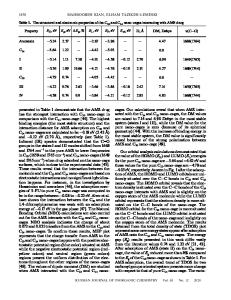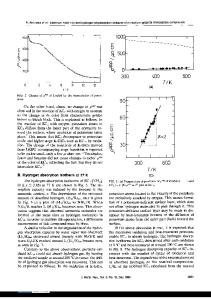Specific Heat Anomaly of C 24 K Arising from Hydrogen Physisorption
- PDF / 244,742 Bytes
- 5 Pages / 420.48 x 639 pts Page_size
- 78 Downloads / 3,453 Views
The University of Tokyo,
AND UICHIRO MIZUTANI Department of Applied Physics, Chikusa-ku, Nagoya 464, Japan
Faculty of Engineering,
Nagoya University,
ABSTRACT Hydrogen/deuterium gas was absorbed in the potassium graphite intercalation compound, C24K, at 77K and then the low temperature specific heats were measured in situ as a function of the hydrogen concentration in the temperature range 1.5-6K. Enhancement of the electronic specific heats upon hydrogen sorption indicates formation of bound states in the vicinity of the Fermi level. Increase of the Debye temperatures by introduction of hydrogen shows the hardening of the lattice. An observed specific heat anomaly was ascribed to a dispersion-less optical phonon with characteristic temperatures of about 17K.
INTRODUCTION Potassium graphite intercalation compounds except for the first stage compound physically absorb hydrogen (H 2 ) and deuterium (D2) molecules at low temperatures. In particular, there is a marked isotope effect in the hydrogen sorption; D2 molecules are more readily taken up by the compounds. These compounds possess slit-shaped vacancies between the intercalated carbon layers in which the sorbed hydrogen is accommodated. Since these vacancies are of molecular dimension and uniform and moreover 'expandable', these compounds exhibit peculiar molecular sieving-effects [1]. The 'expandable' vacancies are partly responsible for the isotope effect [1]. In addition, there is evidence that electronic interaction between the intercalated carbon layers and hydrogen plays an important role in the isotope effect in the hydrogen sorption; H2 /D 2 sorbed is negatively charged and further the degree of negative ion formation for D2 is larger than that for H2 [2]. In the present study, low temperature specific heats of C2 4K were measured as a function of H2 /D 2 . concentration so as to gain further insight into the mechanism of hydrogen sorption. EXPERIMENTAL The compound, C2 4 K, was prepared from a Union Carbide SP-l graphite powder, by means of the dual furnace method. The sample of about 5 g was packed in a vacuum tight Au-plated copper container (see Fig. 1) in a well-controlled dry box filled with argon gas. As shown in Fig. 1, a piece of aluminum foil was adhered on to a small hole of the container, enabling one to introduce hydrogen gas for the measurements in situ. This container together with an ordinary one was placed in a conventional calorimeter, suitable for specific heat measurements. After the foil was cut through by a needle welded on the surface of the
Mat. Res. Soc. Symp. Proc. Vol. 20 (1983) OElsevier Science Publishing Co.,
Inc.
348
needle V
foil
Fig. 1. A schematic cross-section of the calorimeter assembly. The sample, C24K, was packed in a copper container with a piece of aluminum foil on the top. After the container had been set in the calorimeter, the foil was cut through by use of a needle on the surface of the heat switch (k) in vacuo. heat switch, the calorimeter was cooled at 77K and hydrogen gas was introduced. The cont
Data Loading...











